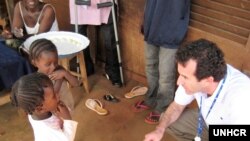The novel coronavirus pandemic sweeping the globe has claimed at least 100,000 lives, most of them in Italy, Spain, China, the United States and Iran. With the death toll soaring even in countries with sophisticated health care, what are the risks for people struggling in refugee and IDP camps? And what might be done to reduce their vulnerability?
Epidemiologist Paul Spiegel, head of the Johns Hopkins (University) Center for Humanitarian Health in Baltimore, Maryland, wrestles with those questions.
“There's a concern that the virus will transmit more quickly because of the densely populated areas, but also that social distancing and isolation will be much more difficult in these settings,” Spiegel says.
The public health doctor speaks with weary familiarity. Before joining the center in 2016, he spent over a dozen years as a U.N. Refugee Agency senior official, responding to crises in the Middle East, East and West Africa, Asia – “really all over the world.”
Spiegel was part of a research team that recently assessed COVID-19 risks in southeastern Bangladesh’s Cox’s Bazar district, home to roughly 855,000 ethnic Rohingya Muslims forcibly displaced from neighboring Myanmar. The team spoke with Rohingyas, aid workers and government personnel. Then it made recommendations – to the United Nations, governments and humanitarian groups – on preparing for an outbreak in overcrowded makeshift camps.
Those recommendations, which could be applied widely, include: anticipating the speed and size of an outbreak; supporting the host government’s ongoing preparations; training people to perform different levels of care giving; and developing and sharing “realistic and detailed” plans to deal with anything – including many deaths.
Spiegel, interviewed via Skype from his home in Baltimore earlier this week, shared these and other insights. He also contributed to a special issue of the journal PLoS Medicine on refugee and migrant health.
The research team’s projections showed proportionally fewer deaths in the Rohingya camps than in Wuhan, China, where the pandemic began .
“That's purely because of demographic characteristics,” Spiegel says, emphasizing the camps’ “massive young population. … And that may play out in many low-income countries where they have a significantly younger population.” Think Africa, which has the world’s youngest populations.
Youth alone may not be a sufficient protective factor, Spiegel says. “Acute malnutrition is elevated amongst these [camp] populations. We haven't seen how that poor underlying health status will affect this disease.” Will younger people in fact be more affected?
People living just outside the camps also are susceptible
“There are many vulnerable host communities surrounding the refugees,” Spiegel says.
“We should not think about refugees as helpless people”
“We need to work with them, and not just say, ‘This is what we should be doing,’” Spiegel says.
Solicit their ideas on precautions such as social distancing or shielding. Don’t assume it’s OK to move elderly or medically compromised people from small family shelters to safer quarters during COVID-19 risks, he says. That might upset people accustomed to multigenerational living.
“Work with the communities to figure out a way that would be culturally acceptable and feasible to try to reduce the spread” of infection.
ACAPS, a group that provides independent humanitarian analysis, echoes Spiegel’s push for community engagement: “Among the Rohingya refugees in Bangladesh, distrust and lack of confidence in the medical system of the [COVID-19] response is widespread. … Rohingya must be engaged and informed … to build trust.”
Plan “for the possibility that refugees will not have access to district or regional hospitals”
In allocating scarce resources such as medical equipment and personnel, “it would not be surprising [if] host governments prioritize their own nationals,” Spiegel says.
So, prepare for task shifting. Health care personnel are “all going to have to task shift up,” Spiegel says. Doctors, of whom there are relatively few for refugees, will have to deal with the sickest patients. Nurses will be tasked with treating patients in moderate condition. Community health workers can help.
Can educated people such as teachers – whose classes have been suspended – be trained to provide basic treatment in repurposed learning centers? “They're usually very well educated,” Spiegel says. “Can we train them to treat some basic components of COVID, perhaps in the household?”
Don’t let governments “use this pandemic as an excuse to crack down on refugees or asylum seekers”
Many governments have been gracious in sheltering displaced people, Spiegel says, citing Turkey and Lebanon taking in Syrians. But the pandemic has prompted more nativist thinking. “Certain governments may try to say, ‘OK, now it's time that we called refoulement,’ ” he says, using the French term for forcible return.
“So we really need to make sure, [in] this crisis and under the guise of public health, that asylum laws and refugee rights and the convention are respected.”








